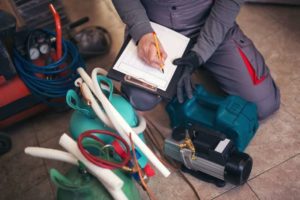How to Test Humidity in Your Home

When outdoors here in the Riverview area, we often have to deal with humid weather. Inside the home, however, residents should do their best to monitor and normalize humidity. Average relative humidity should hover between 35 and 45 percent. Controlled humidity helps protect your home’s structure, preserving and extending the life of your drywall, wood furniture and possessions like musical instruments. Uncontrolled humidity can ruin your indoor air quality as mold spores and bacteria circulate in the air, affecting your health. Since you feel hotter in humid conditions, you may be over-using the AC, wasting energy. Here is how to test humidity in your home.
How to test humidity in your home
- Use a hygrometer to measure the relative humidity level: It’s a small, inexpensive instrument, generally available at the hardware store and some department stores.
- Look for basic signs of high indoor humidity:
- Condensation on windows and/or patio doors
- Mold, mildew or water stains on the ceiling or in corners where walls meet
- Musty, stale odors
- That clammy-skin feeling
- Conduct a capillary test: To find out if moisture is seeping into the house (through foundation, walls and/or floor) or if it’s coming from indoor air. Here’s how to test humidity in your home with this method:
- Identify a damp surface in the house.
- Dry an area 2 ft. x 2 ft. with a portable hair dryer.
- Cover the dry area with a transparent barrier. Tape the edges of the air/vapor barrier (polyethylene preferred) securely to the dry surface.
- Wait two days or so and check for moisture. Is the barrier wet on the room side? Your home’s humidity level may be high. Water beading under the barrier? Moisture is soaking or seeping in from outdoors.
Consult your HVAC professional for an assessment of your home’s humidity. Recommended solutions may include:
- Sealing the home’s envelope against moisture
- Balancing airflow through the home’s duct system and improving ventilation in rooms
- Ensuring exhaust fans are vented to the outdoors
- Adding insulation
- Adding a whole-home dehumidifier
Want to know more about how to test humidity in your home? Visit our website for valuable home comfort information or contact us at Gulf Coast Air Systems, Inc.

